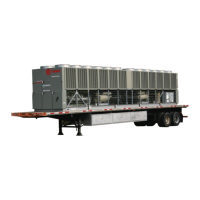105 RTAC-SVX002A-EN
XI-Maintenance Procedures
Refrigerant and Oil Charge Manage-
ment
Proper oil and refrigerant charge is es-
sential for proper unit operation, unit per-
formance, and environmental protection.
Only trained and licensed service per-
sonnal should service the chiller.
Some symptoms of a refrigerant un-
der-charged unit:
• Low subcooling
• Higher than normal discharge super-
heat
• Bubbles in EXV sight glass
• Low liquid level diagnostic
• Larger than normal evaporator ap-
proach temperatures (leaving water
temperature
- saturated evaporator temperature)
• Low evaporator refrigerant tempera-
ture limit
• Low refrigerant temperature cutout di-
agnostic
• Fully open expansion valve
• Possible whistling sound coming from
liquid line (due to high vapor velocity)
• High condenser + subcooler pressure
drop
Some symptoms of a refrigerant over-
charged unit:
• High subcooling
• Evaporator liquid level higher than cen-
terline after shut down
• Larger than normal condenser ap-
proach temperatures (entering condens-
er saturated temperature – entering air
temperature)
• Condenser pressure limit
• High pressure cutout diagnostic
• More than normal number of fans run-
ning
• Erratic fan control
• Higher than normal compressor power
• Very low discharge superheat at startup
• Compressor rattle or grinding sound at
startup
Some symptoms of an oil over-
charged unit:
• Larger than normal evaporator ap-
proach temperatures (leaving water
temperature
- saturated evaporator temperature)
• Low evaporator refrigerant tempera-
ture limit
• Erratic liquid level control
• Low unit capacity
• Low discharge superheat (especially at
high loads)
• Low liquid level diagnostics
• High oil sump level after normal shut
down
Some symptoms of an oil under-
charged unit:
• Compressor rattle or grinding sound
• Lower than normal pressure drop
through oil system
• Seized or welded compressors
• Low oil sump level after normal shut
down
• Lower than normal oil concentrations
in evaporator
R134a Field Charging Procedure
Be certain that the electrical power to the
unit is disconnected before performing
this procedure.
WARNING
Hazardous Voltage w/Capacitors!
Disconnect all electric power, includ-
ing remote disconnects before ser-
vicing. Follow proper lockout/tagout
procedures to ensure the power can-
not be inadvertently energized. For
variable frequency drives or other
energy storing components provided
by Trane or others, refer to the appro-
priate manufacturer’s literature for al-
lowable waiting periods for discharge
of capacitors. Verify with an appropri-
ate voltmeter that all capacitors have
discharged. Failure to disconnect
power and discharge capacitors be-
fore servicing could result in death or
serious injury.
Note: For additional information re-
garding the safe discharge of capaci-
tors.
Factory (initial) Refrigerant Charging
Procedure
The initial charging procedure should be
followed the rst time the unit is charged
in the factory, as well as for charging
any time after the charge has been com-
pletely removed from the entire system
in the event of repair.
1. As part of automatic vacuum/charge
procedure, verify that the EXVs are
OPEN.
2. Attach vacuum hoses to evaporator
service valves (one per circuit). Open
service valves.
3. Attach charging hoses to the charg-
ing port on the liquid line lter (one per
circuit).
The lters contain a port with a ¼” (6mm)
are.
